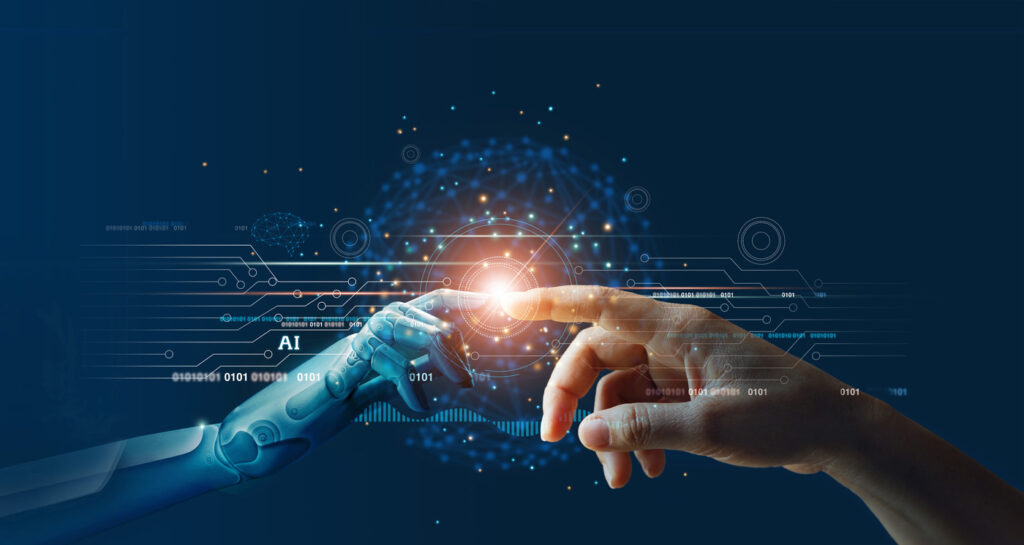Can AI Revolutionize the way we work?

By Kenny Spielman, President of S&B Finishing
Increased productivity, efficiency and cost savings are among the long-term benefits companies expect as they increasingly automate with AI (artificial intelligence). With technology continuing to advance, AI is becoming an essential tool for businesses in a variety of industries. The manufacturing sector, which includes many S&B customers, is no exception. AI is used to help streamline manufacturing processes and improve efficiency in areas from order processing and inventory management to assembly and inspection.
As president of S&B Finishing, I believe that the people who do their work with expertise and dedication are key to our success. Like many others, I wonder whether artificial intelligence will positively or negatively impact people working in manufacturing.
A recent Harvard Business Review article helps clarify how AI can best support humans. In the article, James Wilson and Paul Daugherty, coauthors of Human+Machine: Reimagining work for the Age of AI (Harvard Business Review Press, 2018) outline three general categories for employing smart machines to expand the abilities of human workforces.
- Interacting with customers and employees so humans are free to do higher-level tasks
- Amplifying human cognitive strengths
- Embodying human skills to augment human physical capabilities.
In this blog, I’ll expand on these points to show how AI can potentially benefit companies and the individuals working in them.
Supports human creativity and leadership
One of the most significant advantages of AI in the workplace is its ability to automate repetitive tasks. By taking over mundane and time-consuming tasks, AI allows employees to focus on more critical and creative aspects of their jobs. This not only increases overall productivity but can also lead to higher job satisfaction.
For example, AI-powered chatbots can handle customer inquiries, freeing up customer service representatives to focus on more complex issues. At S&B finishing, we have automated many office processes such as data entry and scheduling. Having support with these kinds of administrative tasks allows employees to concentrate on more strategic initiatives.
Promotes communication and team work
AI can amplify human cognition or intelligence by facilitating better collaboration among team members. This can take the form of streamlining communication and project management to help teams stay organized, track progress and ensure that everyone is on the same page. This leads to improved communication, reduced misunderstandings, and ultimately, a more cohesive and efficient team.
For example, AI can be used to analyze team members’ communication patterns and suggest ways to improve collaboration. Additionally, AI-powered project management tools can help teams prioritize tasks, allocate resources, and monitor progress in real-time.
However, as AI continues to evolve to be able to handle more complex tasks and even express human-like qualities such as sympathy, some people are concerned that robots will replace and displace humans in the workplace.
I see it happening all over. Here at S&B, we will embrace robots if they can be beneficial in the future.
Complements and augments human capabilities
“While AI will radically alter how work gets done and who does it, the technology’s larger impact will be in complementing and augmenting human capabilities, not replacing them,” Wilson and Daugherty note. “Organizations that use machines merely to displace workers through automation will miss the full potential of AI.”
They point to their research and work in the field which inspired guidelines for leaders interested in using AI collaborative intelligence in their companies.
Their data from 1,500 companies showed that the most significant performance improvements took place when humans and machines collaborated, taking advantage of the inherent strengths of each. For humans, those strengths include leadership, teamwork, creativity and social skills. Meanwhile, machines take the lead with speed, scalability, and quantitative capabilities.
To get the most from machine-human collaborations, according to the authors, company leaders need to understand the ways that employees can most effectively augment machines, the ways machines most effectively enhance human strengths, and finally how to redesign business processes to support this partnership.
“We look forward to exploring these strengths at S&B.” We are already using ChatGPT to answer everyday questions about finishing techniques.
Enables data-driven decisions
AI can analyze vast amounts of data quickly and accurately, providing valuable insights that can help businesses make better decisions. By leveraging machine learning algorithms, AI can identify patterns and trends that may not be apparent to the human eye. This enables companies to make data-driven decisions, leading to improved efficiency and a competitive edge in the market.
For instance, AI can be used to analyze customer data to identify potential sales opportunities or to optimize supply chain management by predicting demand and identifying potential bottlenecks.
Certain things like customer service need the human touch. We will never use recordings or machines as a replacement.
Reduces human error and injury
By automating tasks and improving efficiency, AI can help businesses reduce cost in the long run. This is particularly true when it comes to repetitive and massive-scale tasks. AI systems are less prone to making mistakes compared to humans. By automating these tasks, businesses can significantly reduce the risk of human error, leading to improved accuracy and quality of work.
AI can be used to proofread documents, for example, which ensures that they are free from errors before being sent out. Similarly, AI can be used to double-check financial transactions, reducing the risk of costly mistakes.
In manufacturing, robots are evolving from industrial machines which pose more potential danger into smarter, context-aware machines that the HBR article authors call “cobots.” At Mercedes-Benz, arms of these cobots have become an extension of the employee’s body, they explain. These arms handle repetitive heavy lifting actions while humans do complementary tasks that require dexterity and human judgment. Now they can be programmed to sense the location of their human counterparts which has improved safety in the shop.
We are looking for robots to lift heavy parts that our people could not handle. This would add to our current weight capacity, thus enabling many jobs that we used to turn away.
AI helps removing barriers to a healthier bottom line
Such examples show how AI helps growing businesses remove barriers to getting more done, more intelligently, safer and faster. By overcoming common production obstacles with an AI solution, businesses can scale and optimize their operations.
By embracing and using AI technology wisely, businesses can stay ahead of the curve and ensure their continued success in an increasingly competitive market.
We are only beginning to see the vast potential for artificial intelligence to not only contribute to a healthier bottom line, but to transform the workplace. From increased efficiency, creativity and productivity to improved decision-making, safety and collaboration, AI benefits are indeed revolutionizing the way we work. And here at S&B there is no exception. We are investigating additional ways AI can improve our office, as well as our production.

